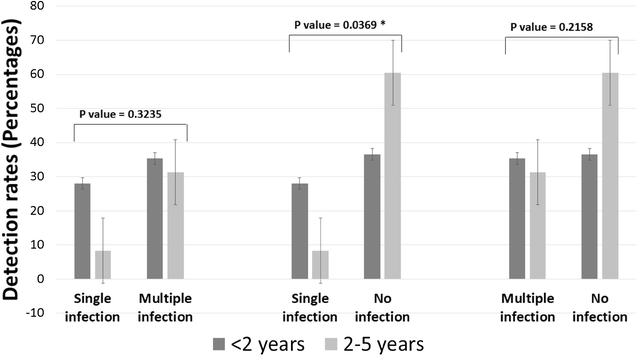Multiple etiologies of infectious diarrhea and concurrent infections in a pediatric outpatient-based screening study in Odisha, India
- PMID: 28400860
- PMCID: PMC5387278
- DOI: 10.1186/s13099-017-0166-0
Multiple etiologies of infectious diarrhea and concurrent infections in a pediatric outpatient-based screening study in Odisha, India
Abstract
Background: There are multiple etiologies responsible for infectious gastroenteritis causing acute diarrhea which are often under diagnosed. Also acute diarrhea is one of the major causes of morbidity and mortality among children less than 5 years of age.
Methods: In our study, fecal samples (n = 130) were collected from children (<5 years) presenting with symptoms of acute diarrhea. Samples were screened for viral, bacterial, and parasitic etiologies. Rotavirus and Adenovirus were screened by immunochromatographic tests. Diarrheagenic Escherichia coli (EPEC, EHEC, STEC, EAEC, O157, O111), Shigella spp., Salmonella spp., Vibrio cholera, Cryptosporidium spp., and Giardia spp. were detected by gene-specific polymerase chain reaction.
Results: Escherichia coli was detected to be the major etiological agent (30.07%) followed by Rotavirus (26.15%), Shigella (23.84%), Adenovirus (4.61%), Cryptosporidium (3.07%), and Giardia (0.77%). Concurrent infections with two or more pathogens were observed in 44 of 130 (33.84%) cases with a predominant incidence particularly in <2-year-old children (65.90%) compared to children of 2-5 years age group (34.09%). An overall result showed significantly higher detection rates among children with diarrhea in both combinations of two as well as three infections concurrently (p = 0.004915 and 0.03917, respectively).
Conclusion: Suspecting possible multiple infectious etiologies and diagnosis of the right causative agent(s) can aid in a better pharmacological management of acute childhood diarrhea. It is hypothesized that in cases with concurrent infections the etiological agents might be complementing each other's strategies of pathogenesis resulting in severe diarrhea that could be studied better in experimental infections.
Keywords: Children; Co-infection; Concurrent infection; Diarrhea; Infectious diarrhea; Odisha.
Figures


References
-
- Kotloff KL, Nataro JP, Blackwelder WC, Nasrin D, Farag TH, Panchalingam S, et al. Burden and aetiology of diarrhoeal disease in infants and young children in developing countries (the Global Enteric Multicenter Study, GEMS): a prospective, case-control study. Lancet. 2013;382:209–222. doi: 10.1016/S0140-6736(13)60844-2. - DOI - PubMed
-
- Kotloff KL, Blackwelder WC, Nasrin D, Nataro JP, Farag TH, Van Eijk A, et al. The Global Enteric Multicenter Study (GEMS) of diarrheal disease in infants and young children in developing countries: epidemiologic and clinical methods of the case/control study. Clin Infect Dis. 2012;55:S232. doi: 10.1093/cid/cis753. - DOI - PMC - PubMed
LinkOut - more resources
Full Text Sources
Other Literature Sources
Miscellaneous

